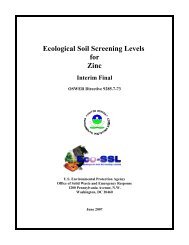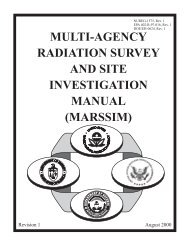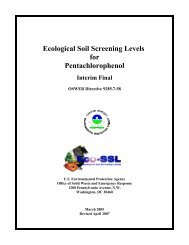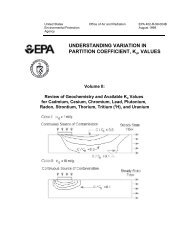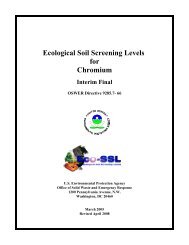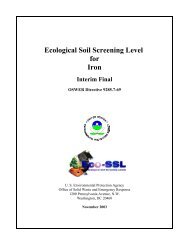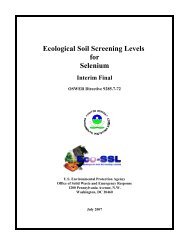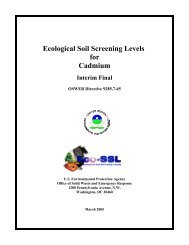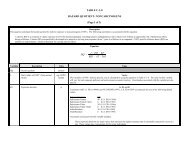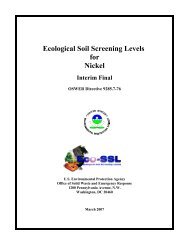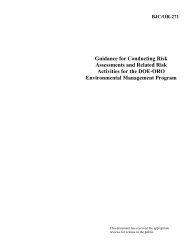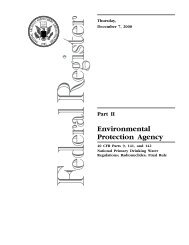- Page 1 and 2: Ecological Soil Screening Levels fo
- Page 3 and 4: TABLE OF CONTENTS 1.0 INTRODUCTION
- Page 5 and 6: 1.0 INTRODUCTION Ecological Soil Sc
- Page 7 and 8: Lead can interfere with the synthes
- Page 9 and 10: Table 3.1 Plant Toxicity Data - Lea
- Page 11 and 12: Result # Table 5.1 Avian Toxicity D
- Page 13 and 14: Within the reviewed papers, there a
- Page 15 and 16: 6.0 ECO-SSL FOR MAMMALIAN WILDLIFE
- Page 17 and 18: Result # Table 6.1 Mammalian Toxici
- Page 19 and 20: Result # Table 6.1 Mammalian Toxici
- Page 21: Result # Table 6.1 Mammalian Toxici
- Page 25 and 26: 7.0 REFERENCES 7.1 General Lead Ref
- Page 27 and 28: Folsomia candida (Collembola). Ecot
- Page 29 and 30: Accumulation of Lead (Pb) by Maize
- Page 31 and 32: Assessment of Heavy Metal Toxicity
- Page 33 and 34: Mix Descamps, M., Fabre, M. C., Gre
- Page 35 and 36: Yoram, and Huang, Jianwei. 1997. Hy
- Page 37 and 38: Und Einem Aquatischen Oekosystem. (
- Page 39 and 40: No Dur Hopkin, S. P. and Martin, M.
- Page 41 and 42: Contaminated by Lead and Zinc. Envi
- Page 43 and 44: No Toxicant Kort, H. S., Schober, G
- Page 45 and 46: Media Lee, K. C., Cunningham, B. A.
- Page 47 and 48: Treated with Lead Arsenate. J Econ
- Page 49 and 50: Mix Nakos, G. 1979. Lead Pollution:
- Page 51 and 52: metal-contaminated alluvial soil. J
- Page 53 and 54: and Lead Solutions. J.Environ.Sci.H
- Page 55 and 56: Activity and Nitrate Assimilation i
- Page 57 and 58: Fiziol.Rast.(Sofia) 14[3], 3-8 Rev
- Page 59 and 60: Mix Weltje, L. 1998. Mixture Toxici
- Page 61 and 62: 7.4 References Used in Deriving Wil
- Page 63 and 64: Clayton, LB, Kitchen, I, and Winder
- Page 65 and 66: Escribano, A., Revilla, M., Hernand
- Page 67 and 68: Hasan, F., Cookman, G. R., Keane, G
- Page 69 and 70: Kendall, RJ and Scanlon, PF. 1982.
- Page 71 and 72: Mcmurry, S. T., Lochmiller, R. L.,
- Page 73 and 74:
Prasada Rao, P. V. V. , Jordan, S.
- Page 75 and 76:
Sokol, R. Z. 1987. Hormonal Effects
- Page 77 and 78:
Yu, S. Y., Mizinga, K. M., Nonavina
- Page 79 and 80:
No Oral Letter from smelter environ
- Page 81 and 82:
No Control Allcroft, R. 1950. Lead
- Page 83 and 84:
Org Met Annau, Z. 1988. Organometal
- Page 85 and 86:
Phys Bailey, C. and Kitchen, I. 198
- Page 87 and 88:
Science. 50(4): 572-580. Fate Bebe,
- Page 89 and 90:
Surv Beyer, W. N., Day, D., Morton,
- Page 91 and 92:
Mix Bishop, Christine A., Boermans,
- Page 93 and 94:
permanent hippocampal damage in Fis
- Page 95 and 96:
FL Bukovjan, K., Hallmannova, A., K
- Page 97 and 98:
Bio Acc Burger, J. , Rodgers, J. A.
- Page 99 and 100:
with heavy metals on the mineral co
- Page 101 and 102:
No Oral Chowdhury, A. R. and Ravell
- Page 103 and 104:
Bio Acc Collins, MF, Hrdina, PD, Wh
- Page 105 and 106:
Mix Cory Slechta, D. A., Pokora, M.
- Page 107 and 108:
chemical Agents. J Obstet Gynaecol
- Page 109 and 110:
25-39 Imm Descotes, J. R. Tedone, a
- Page 111 and 112:
Bact Dolinsky, Z. S., Burright, R.
- Page 113 and 114:
FL Dumas, P., Gueldry, D., Loireau,
- Page 115 and 116:
Mix Elgerwi, A. Al-Fateh and Bires,
- Page 117 and 118:
Stain Figueiredo, B. C., Skup, M.,
- Page 119 and 120:
No Dose Fowler, B. A., Kimmel, C. A
- Page 121 and 122:
Mix Fullmer, C. S. 1995. Dietary ca
- Page 123 and 124:
Surv Getz, L. L., Best, L. B., and
- Page 125 and 126:
Fate Govoni, S., Memo, M., Spano, P
- Page 127 and 128:
Surv Guitart, R., To Figueras, J.,
- Page 129 and 130:
Abstract Hanna, L., Peters, J. M.,
- Page 131 and 132:
HHE Hemberg, S., Nikkanen, J, Melli
- Page 133 and 134:
Surv Hillis, T. L. and Parker, G. H
- Page 135 and 136:
Pb Behav Hong, J. S., Tilson, H. A.
- Page 137 and 138:
FL Inouye, M. 1989. Teratology of h
- Page 139 and 140:
HHE Janghorbani, M. and Young, V. R
- Page 141 and 142:
Bio Acc Kaiser, T. E., Reichel, W.
- Page 143 and 144:
Lead Shot Kendall, R. J. and Scanlo
- Page 145 and 146:
Drug Kitchen, I. and McDowell, J. 1
- Page 147 and 148:
Unrel Kopp, S. J., Glonek, T., Erla
- Page 149 and 150:
Abstract Krigman, MR, Butts, SA, Ho
- Page 151 and 152:
No Dose Lazareno, S and Nahorski, S
- Page 153 and 154:
Prim Levin, E. D., Schneider, M. L.
- Page 155 and 156:
Lead Shot Longcore, J. R., Locke, L
- Page 157 and 158:
Surv Maedgen, J. L, Hacker, C. S.,
- Page 159 and 160:
No Dose Massaro, E. J. and Massaro,
- Page 161 and 162:
No Oral McGowan, C. 1989. Influence
- Page 163 and 164:
CP Michaelson, I. A., Greenland, R.
- Page 165 and 166:
Lead Shot Moore, J. L., Hohman, W.
- Page 167 and 168:
No Dose Munoz, C., Garbe, K., Lilie
- Page 169 and 170:
Drug Nation, J. R., Dugger, L. M.,
- Page 171 and 172:
cutanee induite par le laurylsulfat
- Page 173 and 174:
Surv Ohlendorf, Harry M., Hothem, R
- Page 175 and 176:
Surv Pain, D. J. 1989. Hematologica
- Page 177 and 178:
Surv Peles, J. D. and Barrett, G. W
- Page 179 and 180:
No COC Plus, R. 1992. A review of i
- Page 181 and 182:
CP Rasile, D. A., Donovick, P. J.,
- Page 183 and 184:
Prim Rice, D. C. 1984. Behavioral D
- Page 185 and 186:
Aquatic Roper, J. M., Cherry, D. S.
- Page 187 and 188:
Lead Shot Sanderson, G. C., Anderso
- Page 189 and 190:
Unrel Schoemaker, N. J., Lumeij, J.
- Page 191 and 192:
Bio Acc Sharma, Rp, Street, Jc, Shu
- Page 193 and 194:
Challenge, and Influence of Treatme
- Page 195 and 196:
Diss Spahn, S. A. 1997. Colonial Wa
- Page 197 and 198:
Surv Stendell, R. C., Smith, R. I.,
- Page 199 and 200:
No Oral Sundstrom, R., Conradi, N.
- Page 201 and 202:
Mix Thawley, D. G., Willoughby, R.
- Page 203 and 204:
Bio Acc Tsuzuki, Toshihumi, Kotani,
- Page 205 and 206:
No Dose Varma, M. M., Joshi, S. R.,
- Page 207 and 208:
FL Vogt, H. and Nezel, K. 1976. The
- Page 209 and 210:
Lead Shot Wayland, M. and Bollinger
- Page 211 and 212:
Species Williams, Phillip L. and Du
- Page 213 and 214:
CP Woolley, D. E. and Woolley-efige
- Page 215 and 216:
Surv Zechalko, A. 1979. Effect of N
- Page 217 and 218:
Rejection Criteria Literature Rejec
- Page 219 and 220:
Rejection Criteria Literature Rejec
- Page 221 and 222:
Rejection Criteria Literature Rejec
- Page 223 and 224:
Appendix 5-1 Avian Toxicity Data Ex
- Page 225 and 226:
Result # Ref N. Chemical Form MW% T
- Page 227:
Result # Ref N. Chemical Form MW% T
- Page 230 and 231:
This page intentionally left blank
- Page 232 and 233:
Result # Ref N. Chemical Form MW% A
- Page 234 and 235:
Result # Ref N. Chemical Form MW% A
- Page 236 and 237:
Result # Ref N. Chemical Form MW% A
- Page 238 and 239:
Result # Ref N. Chemical Form MW% A
- Page 240 and 241:
Result # Ref N. Chemical Form MW% A
- Page 242:
Result # Ref N. Chemical Form MW% A



